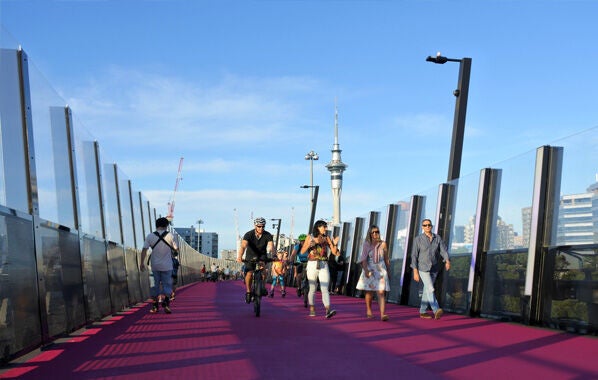Best foot forward

With a flurry of large-scale apartment developments going up in and around Auckland’s city centre, the number of residents within a short walk (or cycle) of work is exploding.
The CBD residential population is already the equivalent of a medium-sized city in its own right, hitting 45,000 in 2017, some 15 years earlier than Auckland Council had predicted in its 2012 city centre masterplan.
According to Statistics New Zealand, the city centre population is growing six times faster than the rest of the region and it is tipped to soar to at least 75,000 by 2027.
For this rapidly swelling population, the likes of pedestrian-friendly improvements and the avant-garde pink cycleway have offered more than just sightings of commuters pairing Puma with Prada.
They provide tangible lifestyle, financial and property advantages for owners and investors in ‘commute-free’ or walkable/cyclable homes, with easy access to workplaces, entertainment and shopping.
For central dwellers, a free commute can represent savings of thousands of dollars a year compared with suburbanites who make the daily journey into town on public transport, even from relatively central suburbs. The savings can be much greater compared with those who live further out, and those who drive.
Trent Quinton, Bayleys’ leading residential salesperson and apartment specialist, says these are unique considerations shaping the CBD market, which are factored into prices and purchasing decisions by homebuyers and investors.
“Parking is expensive, vehicle emissions contribute to climate change, traffic is draining – yet it’s estimated that 83 percent of Auckland’s population living outside the city centre drive a car to work.
“This, compared with 75 percent of those living in the central city that walk, cycle or utilise public transport.
“The morning commute has become a lifestyle choice – more than 12,000 new residents have moved into Auckland’s city centre within the last three years, resulting in a shifting dynamic.”
Recent Bayleys analysis identified Auckland’s apartment-rich CBD among national ‘sweet spots’ for residential property investment, with the median rental income easily covering the mortgage repayments for the median-priced rental property.
But Quinton says the area is also of growing appeal among buyers seeking a home.
“Apartments in the CBD, once dominated by investors, are experiencing greater parity with owner-occupiers. However, the central population remains relatively young, with 58 percent aged between 15 and 29.”
Quinton says there used to be a stigma attached to the city – grubby, unexciting. Yet massive investment from the private and public sectors in the likes of transport infrastructure, green spaces and dining precincts have coaxed people back.
Covering an area of 4.33 square kilometres, Auckland’s central city represents New Zealand’s highest population density with nearly 12,000 people per square kilometre.
“With such a high concentration of residents, it’s little surprise that the CBD holds 59 percent of the region’s apartment and multi-unit housing supply,” say Quinton.
Benefitting from an uptake in interest since 2012, new apartment developments have also grown in popularity beyond the CBD’s boundaries.
“Suburbs known as ‘city-fringe’ have emerged as desirable due to proximity to arterial transport routes, cafes, restaurants, entertainment, schooling – and of course work.
“These neighbourhoods are an ideal location for high-end apartment developments, which have proven popular with retirees and home-owners moving from more traditional stand-alone properties.
Meanwhile, suburbs further afield will retain their own attraction for buyers, particularly around improvements in public transport infrastructure.
“There has been investment into creating ‘active’ commuter routes from beyond the CBD – these cycle lanes, improved bus networks and train connections have made it more attractive for workers to live outside the city and commute daily.
“Between 2018 and 2026, this kind of infrastructure is expected to support an increase of public transport capacity by 40 percent.
“For investors, the trend towards suburban development has fuelled a rise in average weekly rent, Ellerslie for example has seen weekly rents rise by 16 percent since 2016, compared with the central city which has grown by 4 percent.”
Quinton says this has seen some investors change tack, seeking the best of both worlds by purchasing properties in city-adjacent neighbourhoods that benefit from infrastructure spending while still remaining ‘suburban’.
Interestingly, of Auckland’s suburban residents, 35 percent are households without children, compared with 75 percent of the city centre’s households.
“What we’re seeing is a divergence between the suburban market and those purchasing property in Auckland’s city centre,” Quinton explains.
“Differences between the city centre, city fringe and suburban property markets are increasingly dictated by our own, and our family’s transport requirements.”